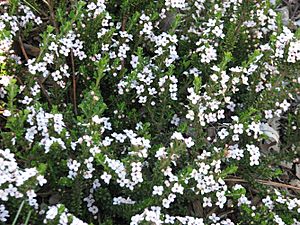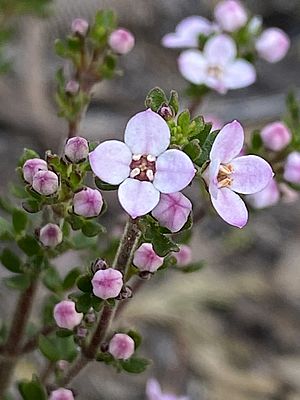Lemon-scented zieria facts for kids
Quick facts for kids Lemon-scented zieria |
|
|---|---|
 |
|
| Zieria citriodora in the Royal Botanic Gardens, Melbourne | |
| Conservation status | |
| Scientific classification | |
| Genus: |
Zieria
|
| Species: |
citriodora
|
| Synonyms | |
|
|
The Zieria citriodora, also known as the lemon-scented zieria, is a type of flowering plant. It belongs to the citrus family called Rutaceae. This plant is special because it only grows in a small area near the border of New South Wales and Victoria in Australia. It's a small bush with leaves that smell like lemons. Its tiny flowers are usually pale pink or white and bloom from late winter into summer.
Contents
What it Looks Like
The lemon-scented zieria is a small, rounded bush. It usually grows about 15 to 20 centimeters (6 to 8 inches) tall. It can spread out to about 30 centimeters (1 foot) wide. This plant often grows from underground stems called rhizomes.
Its branches have tiny oil glands and are covered in soft, short hairs. As the plant gets older, these hairs might disappear. The leaves are made of three small parts called leaflets. The middle leaflet is about 4 to 5 millimeters long and 1.5 to 2 millimeters wide. Each leaflet has oil glands and soft hairs. Their edges are often rolled under. When you crush the leaves, they have a strong lemon scent.
Flowers and Fruit
The flowers grow either by themselves or in small groups of up to three. They appear where the leaves meet the stem. The small, triangular parts that protect the flower bud, called sepals, are about 1.4 millimeters long and hairy.
The plant has four petals, which are white to pale pink. They are about 4 to 6 millimeters long and overlap each other. These petals are covered with tiny, soft hairs. The lemon-scented zieria blooms from late winter through summer. After the flowers, small fruits grow. These fruits are also hairy and have tiny oil glands.
Where it Grows
The lemon-scented zieria mostly grows in shallow, rocky, or sandy soils. It likes moderately steep slopes in open eucalypt woodlands. You can find small groups of these plants in both New South Wales and Victoria.
In New South Wales, there are two main groups of plants. They are found in the Kybeyan Range, which is east of Cooma. In Victoria, there are four groups of plants in East Gippsland. All these areas are part of the South Eastern Highlands region.
Why it Needs Protection
The lemon-scented zieria is a rare plant. In New South Wales, there are fewer than 600 individual plants in total. About 150 of these are on public land near Numerella. Another 32 plants are on private land near Kybeyan. In Victoria, a count in 2004 found about 260 plants. All of these are in the Alpine National Park near Omeo.
This plant faces several dangers. Animals like kangaroos and domestic farm animals sometimes eat them. New houses being built in rural areas can also threaten their habitat. Changes in how often fires happen in the area can also harm the plants. Because of these threats, the lemon-scented zieria is listed as "vulnerable" under a special law called the Environment Protection and Biodiversity Conservation Act 1999. This means it needs protection to survive.
Growing Lemon-Scented Zieria
If you want to grow lemon-scented zieria, it's easiest to start with cuttings. These plants grow best in soil that drains water well and is a bit acidic. They don't need much fertilizer. If the soil drains well, they usually don't get many pests or diseases. This plant can also handle cold weather and frost. It can grow well in places that are open to the wind or partly shaded.



